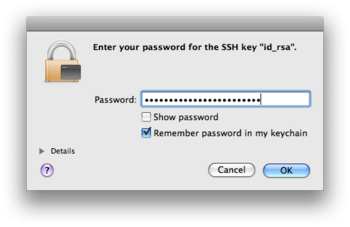HPC/Network Access/SSH Tunnel Setup on Linux and MacOS
The following sections document how to establish ssh tunneling on a Linux or MacOS X machine running OpenSSH. Numerous Windows solutions are available to provide the same functionality, but details vary considerably.
Manual setup
On your computer, run the following commands:
0. (Windows only) Start your X11 server if you have one.
1. Open a terminal window (such as Mac Terminal, Cygwin, PuTTY, or xterm).
2. Type:
ssh -v -L 33301:carbon:22 username@mega.cnm.anl.gov
- Do not type any further commands in this window.
3. Minimize that window - no further commands need be typed there.
4. Open another terminal window.
5. Type:
ssh -Y -p 33301 username@localhost
- Replace
usernameby the name of your Argonne account name. - Steps 4 and 5 can be repeated as often as desired.
- Replace
Do not type any commands at a prompt on mega.
Using an ssh config file
To simplify making connections from your computer, create or use an ssh configuration file on it.
Config file contents
On your computer:
- Close any Carbon windows opened previously.
- Open a new terminal window.
- Linux: xterm
- Mac: Terminal.app
- Windows: a Cygwin window.
- Copy&paste the following text into your ~/.ssh/config file.
NoHostAuthenticationForLocalhost yes
Host mega
Hostname mega.cnm.anl.gov
User argonne_user_name
LocalForward 33301 carbon:22
LocalForward 33380 carbonmgmt:80
Host carbon
Hostname localhost
User argonne_user_name
Port 33301
ForwardX11 yes
ForwardX11Trusted yes
- Replace the string argonne_user_name with the name of your Argonne domain account.
- Remove write permissions to the config file, its parent directory, and your home for anyone but you:
chmod go-rwx ~/.ssh ~/.ssh/config
chmod go-w ~
- Note for Cygwin users: To paste text into a Cygwin window, right-click with your mouse or use the Shift-Ins keyboard shortcut.
- Simply Copy & Paste the line from this browser window to your terminal.
- Advanced users: See the ssh_config man page for syntax and options of the config file.
Connecting with a config file
With the config file in place, the commands in section #Manual setup above simplify to:
- 1. In one window, run the following command, then minimize the window:
ssh -v mega
- Do not type any further commands here. (You can use the -N option to intentionally suppress a command prompt.)
- 2. Use other terminals as often as needed to log in interactively:
ssh carbon
Advanced: Connecting to a specific login node
The configuration described above uses a generic host name carbon, which at present will lead to one specific login node.
However, you may want to connect to another node that you have used previously, such as to reconnect to a VNC sesssion.
To do so, change your .ssh/config to forward additional ports and set up more specific Host aliases.
- Similar to the above, copy&paste the following text into your ~/.ssh/config file.
NoHostAuthenticationForLocalhost yes
Host mega
Hostname mega.cnm.anl.gov
User argonne_user_name
LocalForward 33301 carbon:22
LocalForward 33305 clogin5:22
LocalForward 33306 clogin6:22
LocalForward 33380 carbonmgmt:80
Host carbon
Port 33301
Host clogin5
Port 33305
Host clogin6
Port 33306
Host carbon clogin*
Hostname localhost
User argonne_user_name
ForwardX11 yes
ForwardX11Trusted yes
With this modified config file in place, you can connect to the network-default carbon, but also to the specific login hosts you configured.
- 1. Run once in your desktop session:
ssh -v mega
- 2. Run as often as needed, any one of these commands:
ssh clogin5 ssh clogin6 …
Test remote graphics using X11
- In a terminal connected to a Carbon login node, run the command:
echo $DISPLAY
- You should get something like:
localhost:17.0
- The actual number will vary.
- Start a simple X11 program:
xload
- You should see a small window pop up on your screen, labeled "login5" or "login6".
- Close the window using its close button or press Ctrl-C in the terminal window.
- Now use graphical applications on Carbon, for instance:
gnuplot
- This will start the gnuplot interpreter in the terminal.
- Create a sample plot. At the
gnuplot>prompt, type:plot sin(x)
- Exit the program:
exit
File transfer
- There are many ways to transfer files through an ssh tunnel. However, you must always initiate the connection from the remote machine (your home computer), and either push files to Carbon or pull files from Carbon.
- With the above tunnel setup you cannot initiate a file transfer from Carbon or mega.
- Do not use mega as an intermediate. Files stored there wil be deleted.
- Prerequisite
- The command examples below require that a tunnel-establishing connection to
megais open. Follow section #Manual setup or #Connecting with a config file above to open or re-open this connection if needed.
Without SSH config file
Run the following example commands on your machine.
- Copy to Carbon – "push"
scp -P 33301 -p 'foofile' argonne_user_name@localhost:'dir/on/carbon/'
- Copy from Carbon – "pull"
scp -P -p argonne_user_name@localhost:'dir/on/carbon/name_on_carbon' destination_on_your_machine/
- Type
localhostas written. Together with the option-P 33301(or-o port=numberfor older scp versions) it refers to the tunnel that you have set up earlier. - Replace
argonne_user_nameby the user name you have at Argonne.
With an SSH config file
Run the following example commands on your machine.
Copy a file to Carbon (push from outside)
- With the above ssh/.config file in place:
scp -p 'foofile' carbon:'dir/on/carbon/'
Copy a whole directory to Carbon
Short of using tar or zip:
scp -rp 'local/path/' carbon:'dir/on/carbon/'
This method does not preserve symbolic links.
Copy a file from Carbon (pull from outside)
scp -p carbon:remote/path/foo local/path/ scp -p carbon:remote/path/foo .
Note the trailing "." in the last example to copy to your current directory.
- Reverse tunneling
The file copy operations above must all be initiated on the outside host. It is possible to set up tunnels to be able to initiate file operations on the inside. However, this is more complex and will be left as an exercise for advanced users. It involves setting up:
- agent forwarding
- a
.ssh/configfile on Carbon, and - specifying
-Rcommand line options orRemoteForwardconfig file directives when accessingcarbonat the second stage.
Bonus – Intranet web access
Open the following links in a browser on your external workstation:
https://localhost:33343/cnm/HPC http://localhost:33380/
Copy a file to Carbon from a third host
0. Similar to the procedure in section #Manual setup above, open two interactive sessions to the remote computer.
1. From the first session, open a connection to Mega and forward a port:
ssh -v -L 33301:carbon:22 username@mega.cnm.anl.gov
- Do not type any further commands there.
2. In the second session, test if you can reach Carbon interactively.
ssh -Y -p 33301 -o NoHostAuthenticationForLocalhost=yes username@localhost
3. Close the Carbon connection from step 2.
exit
- You should arrive back at the prompt of the third host.
4. From the second session again, initiate the file transfer as:
scp -v -p -o port=33301 -o NoHostAuthenticationForLocalhost=yes \
filename_remote username@localhost:[target_directory/][filename_on_carbon]
- Replace
usernameby the name of your Argonne account name. - Note the ":" at the end of the host name, which tells the
scpcommand that the copy target is on a remote host. - The file named
filename_remotewill arrive in your Carbon home directory under this name, unless you specify atarget_directoryand/or afilename_on_carbon.
- Replace
5. When done, press Ctrl-C in the first session to terminate the connection to mega.
Advanced: Speeding up logins using ssh keys
Our SSH gatway host itself does not accept SSH keys – you must always type your password for the initial connection to Mega.
Once you have established this initial connection and your tunnels are configured, you can use SSH keys to log in to Carbon login nodes without further passwords.
Create a key
- Create an ssh key pair key if you do not already have one :
yourcomputer$ ssh-keygen -t rsa
The output will look like:
Generating public/private rsa key pair. Enter file in which to save the key (/Users/home_id/.ssh/id_rsa): Enter passphrase (empty for no passphrase): <-- Choose and enter a password. Enter same passphrase again: Your identification has been saved in /Users/home_id/.ssh/id_rsa. Your public key has been saved in /Users/home_id/.ssh/id_rsa.pub. The key fingerprint is: 42:c3:72:fb:4c:be:c6:80:81:bc:8b:73:d8:88:84:2e home_id@yourcomputer.local
- Inspect the .ssh directory on your computer. It should contain the following files:
$ ls -1 ~/.ssh config id_rsa id_rsa.pub known_hosts random_seed
- id_* are the just created key files.
Using an ssh-agent
On modern systems, the mere presence of private keys with their default names triggers handling through ssh-agent and brings up a passphrase dialog at the start of the desktop session or when a key is first requested for an outgoing connection. This is the case on MacOS X since 10.5 (Leopard), where key management is secure and largely automated through its general keychain concept.
On older systems, you need to (a) set up the session to run under ssh agent and (b) request the passphrase upon login. Circumstances vary widely. Ask Google or your local admin for help. See also the page Getting started with SSH.
Place your public key on Carbon
To productively use your ssh key pair, you need to transfer the public half to Carbon.
Requirements:
- you have a public/private ssh key pair on your machine (called yourcomputer in this example).
- the public file on yourcomputer is named
~/.ssh/id_rsa.pubor~/.ssh/id_dsa.pub(either one will work). - the ssh host alias
megahas been set up on yourcomputer in~/.ssh/configand defines tunnels usingLocalForwarddeclarations. - the tunnel connection for mega is open, i.e., on yourcomputer,
ssh megaruns in another terminal. - the ssh alias
carbonhas been set up as described above. - an interactive session
ssh carbonsucceeds.
Then, to transfer your public key from yourcomputer to the Carbon login nodes, type:
cat ~/.ssh/id_rsa.pub | ssh carbon "umask 033; mkdir -p .ssh; cat >> .ssh/authorized_keys"
This command will append the contents of your ssh public key on yourcomputer to an authorized_keys file on Carbon. The command above is more reliable than cut&paste across interactive terminal sessions. If you created a dsa-type key, or chose your own name for the key pair, you'll have to cat the appropriate file instead. Remember to use the public part of the key, i.e. the file id_foo.pub.
Troubleshooting
General connection issues
Run ssh with one or more -v options ("verbosity"), and record the output for diagnostic (copy&paste into a file). E.g.:
ssh -v -v [other options and arguments …]
If you cannot resolve the issue yourself, follow HPC/Support.
Public keys
If public keys do not work, use your password to gain access, then check the following:
- Permissions
- The directories and the
authorized_keysfile must, at the least, not be writable by anyone except yourself; other permissions are recommended to be restrictive as well:
login5$ ls -ld ~ ~/.ssh ~/.ssh/authorized_keys drwxr-xr-x 28 argonne_id users 4096 Feb 22 13:52 /home/argonne_id drwx------ 4 argonne_id argonne_id 4096 Feb 18 21:25 /home/argonne_id/.ssh -rw------- 1 argonne_id argonne_id 829 Oct 9 10:55 /home/argonne_id/.ssh/authorized_keys
- To change:
login5$ chmod go-w ~ login5$ chmod go-rwx ~/.ssh ~/.ssh/authorized_keys
- Corruption of
authorized_keysfile - The file should contain public keys in OpenSSH format, one per line, without additional line breaks. One way to check is:
yourcomputer$ cut -c1-50 ~/.ssh/authorized_keys ssh-rsa AAAAB3NzaC1yc2EAAAABIwAAAIEjdsfjJSAHkjh88y ssh-dss AAAAB3NzaC1kc3MAAACBAkkjsadfJFg7EFjDJhWEjk
The output should look similar to the sample above. Use your favorite text editor to join erroneously broken lines.
Note that there should not be anything like BEGIN RSA PRIVATE KEY, which would obviously indicate a private, rather than public key.
- Verify that an ssh-agent is running
To verify that an ssh-agent is running and visible to your shell, check for the presence of the environment variable SSH_AUTH_SOCK. To list the keys it has loaded, use ssh-add -l (lowercase "L"). Typical output is as follows:
yourcomputer$ echo $SSH_AUTH_SOCK /tmp/ssh-HCvZKt5478/agent.5478 yourcomputer$ ssh-add -l 1024 b9:65:98:c0:7c:25:da:b6:86:48:98:6b:2a:5a:9d:21 /Users/home_id/.ssh/id_rsa (RSA)



